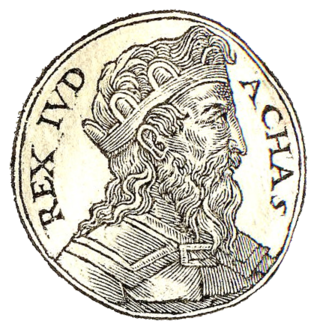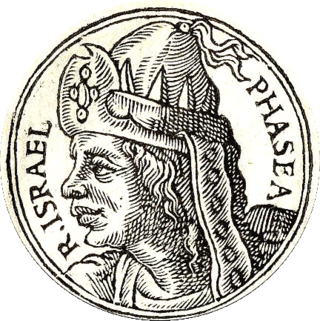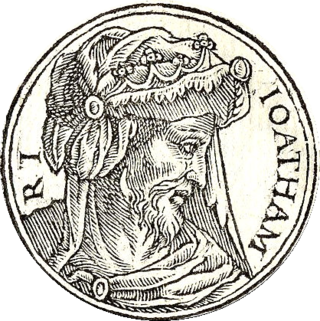Related Research Articles
The 8th century BC started the first day of 800 BC and ended the last day of 701 BC. The 8th century BC was a period of great change for several historically significant civilizations. In Egypt, the 23rd and 24th dynasties lead to rule from Kingdom of Kush in the 25th Dynasty. The Neo-Assyrian Empire reaches the peak of its power, conquering the Kingdom of Israel as well as nearby countries.
This article concerns the period 719 BC – 710 BC.
This article concerns the period 729 BC – 720 BC.
This article concerns the period 739 BC – 730 BC.

Ahaz an abbreviation of Jehoahaz II, "Yahweh has held" was the twelfth king of Judah, and the son and successor of Jotham. Ahaz was 20 when he became king of Judah and reigned for 16 years.

Tiglath-Pileser III was the king of the Neo-Assyrian Empire from 745 BC to his death in 727. One of the most prominent and historically significant Assyrian kings, Tiglath-Pileser ended a period of Assyrian stagnation, introduced numerous political and military reforms and more than doubled the lands under Assyrian control. Because of the massive expansion and centralization of Assyrian territory and establishment of a standing army, some researchers consider Tiglath-Pileser's reign to mark the true transition of Assyria into an empire. The reforms and methods of control introduced under Tiglath-Pileser laid the groundwork for policies enacted not only by later Assyrian kings but also by later empires for millennia after his death.

Pekah was the eighteenth and penultimate king of Israel. He was a captain in the army of king Pekahiah of Israel, whom he killed to become king. Pekah was the son of Remaliah.
Nabû-nāṣir was the king of Babylon from 747 to 734 BC. He deposed a foreign Chaldean usurper named Nabu-shuma-ishkun, bringing native rule back to Babylon after twenty-three years of Chaldean rule. His reign saw the beginning of a new era characterized by the systematic maintenance of chronologically precise historical records. Both the Babylonian Chronicle and the Ptolemaic Canon begin with his accession to the throne. He was contemporary with the Assyrian kings Aššur-nirarī V and Tiglath-Pileser III, the latter under whom he became a vassal, and the Elamite kings Humban-Tahrah I and Humban-Nikaš I.

Menahem or Menachem was the sixteenth king of the northern Israelite Kingdom of Israel. He was the son of Gadi, and the founder of the dynasty known as the House of Gadi or House of Menahem.

Jotham or Yotam was the eleventh king of Judah, and son of King Uzziah and Jerusha, daughter of Zadok. Jotham was 25 years old when he began his reign, and he reigned for 16 years. Edwin R. Thiele concluded that his reign commenced as a coregency with his father, which lasted for 11 years. Because his father Uzziah was afflicted with tzaraath after he went into the Temple to burn incense, Jotham became governor of the palace and the land at that time, i.e. coregent, while his father lived in a separate house as a leper.
Tiglath-Pileser may refer to:
Ashur-nirari V was the king of the Neo-Assyrian Empire from 755 BC to his death in 745 BC. Ashur-nirari was a son of Adad-nirari III and succeeded his brother Ashur-dan III as king. He ruled during a period of Assyrian decline from which few sources survive. As such his reign, other than broad political developments, is poorly known.

The Arslan Tash reliefs are bas-reliefs of human figures and animals which adorned the city gates and temple portals of ancient Hadatu; the modern archeological site of Arslan Tash, literally "the Stone Lion".

Bit Agusi or Bit Agushi was an ancient Aramaean Syro-Hittite state, established by Gusi of Yakhan at the beginning of the 9th century BC. It had included the cities of Arpad, Nampigi (Nampigu) and later on Aleppo Arpad was the capital of the state-kingdom. Bit Agusi stretched from the A'zaz area in the north to Hamath in the south.

Bit-Amukani was a tribe, proto-state founded by Chaldeans in southern Mesopotamia which stretched from southeast of Nippur to the area of Uruk. It is considered as one of the most powerful Chaldean tribes, next to Bīt-Iakin and Bīt-Dakkūri.
The Battle of Kummuh marked the end of the Urartu hold on northern Syria, as Tiglath-pileser III defeated Sarduri II in 742 B.C.
References
- ↑ "Figure 4: Distribution of major Alonella clades (both original and sequences retrieved from NCBI GenBank)". doi: 10.7717/peerj.10804/fig-4 .
{{cite journal}}: Cite journal requires|journal=(help)